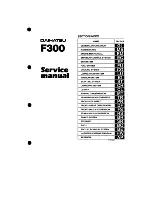
Do not carry heavy or hard objects in the
passenger compartment unless they are
firmly secured in place.
For more information, please refer to the
“Loading and storing section”.
Unsecured or improperly positioned cargo
increases a child’s risk of injury in the
event of
R
strong braking maneuvers
R
sudden changes of direction
R
an accident
Infant and child restraint system
We recommend all infants and children be
properly restrained at all times while the
vehicle is in operation.
The passenger lap-shoulder belt has a
special seat belt retractor for secure
fastening of child restraints.
To fasten a child restraint, follow all
mounting instructions provided by the
child restraint manufacturer. Then pull the
shoulder seat belt out completely and let it
retract. During seat belt retraction, a
ratcheting sound can be heard to indicate
that the special seat belt retractor is
activated. The seat belt is now locked. Push
down on child restraint to take up any
slack.
To deactivate, release seat belt buckle and
let seat belt retract completely. To
deactivate the special seat belt retractor
for the passenger seat, the passenger seat
must be in the most backward position. The
seat belt can again be used in the usual
manner.
Never release the seat belt buckle while the
vehicle is in motion, since the special seat
belt retractor will be deactivated.
The use of infant or child restraints is
required by law in all 50 states, the
District of Columbia, the U.S. territories,
and all Canadian provinces and
territories.
Infants and small children should be seated
in an appropriate infant or child restraint
system properly secured in accordance
with the manufacturer’s instructions for
the child restraint, that complies with U.S.
Federal Motor Vehicle Safety Standards 213
and 225 and Canadian Motor Vehicle Safety
Standards 213, 213.1 and 213.2.
A statement by the child restraint
manufacturer of compliance with these
standards can be found on the instruction
label on the restraint and in the
instruction manual provided with the
restraint.
When using any infant restraint, toddler
restraint, or booster seat be sure to
carefully read and follow all
manufacturer’s instructions for
installation and use.
Please read and observe warning labels
affixed to the inside of the vehicle and to
infant or child restraints.
Children 12 years old and under must be
seated and properly secured in an
appropriately sized infant restraint,
toddler restraint, or booster seat
recommended for the size and weight of the
child.
The infant or child restraint must be
properly secured with the vehicle’s seat
belt fully in accordance with the child seat
manufacturer’s instructions.
Occupants, especially children, should
never place their bodies or lean their
heads in the area of the door where the
head-thorax air bags (cabriolet), window
curtain air bags (coupé) and thorax-pelvis
air bags (coupé) inflates. This could result
in serious injuries or death should the
head-thorax air bags (cabriolet), window
curtain air bags (coupé) and thorax-pelvis
air bags (coupé) be triggered. Always sit as
upright as possible, properly use the seat
Occupant safety
41
>> Safety.
Z
Summary of Contents for fortwo cabriolet
Page 1: ...Operator s Manual smart fortwo coup and smart fortwo cabriolet...
Page 4: ......
Page 29: ...Safety Occupant safety 28 Panic alarm 43 Driving safety systems 44 Anti theft systems 47...
Page 50: ...48...
Page 96: ...94...
Page 138: ...136...
Page 180: ...Fuse box Front side Fuse y Backup fuse slots 178 Fuses Practical hints...
Page 184: ...182...
















































